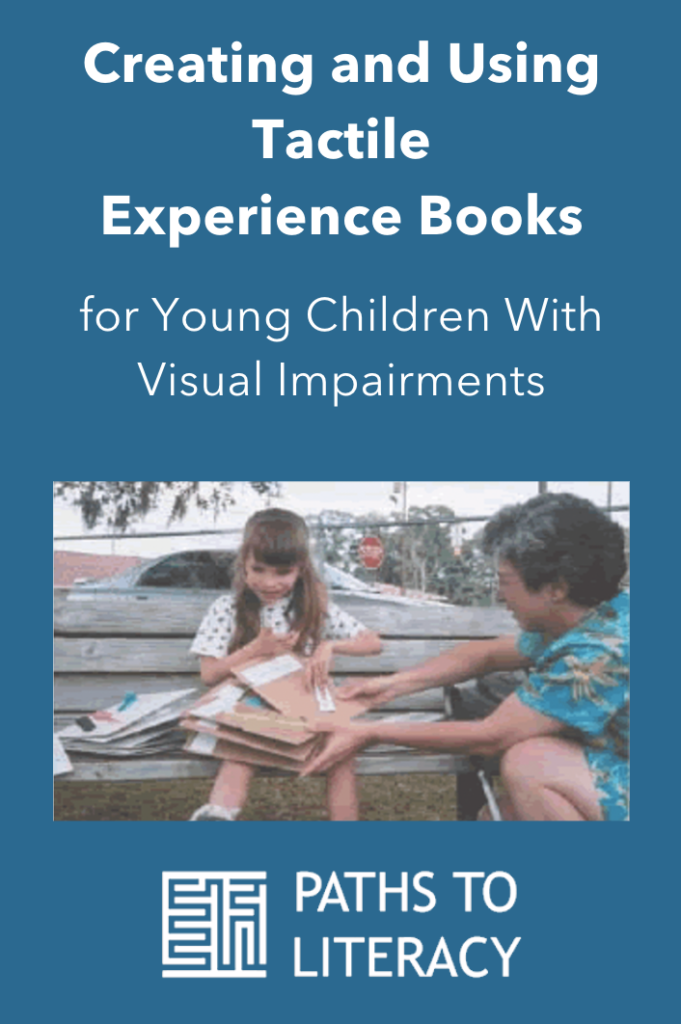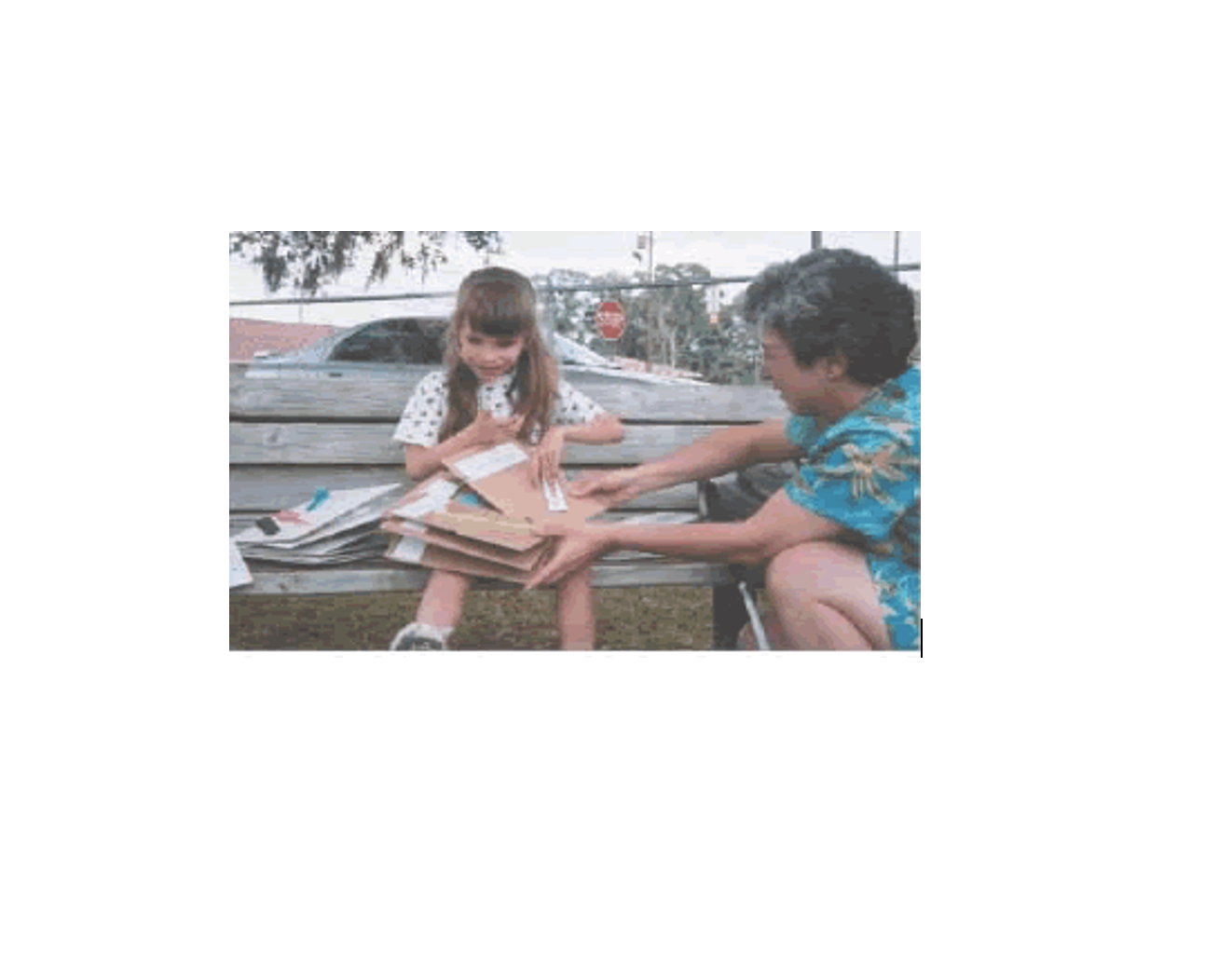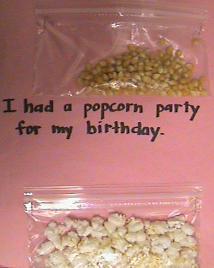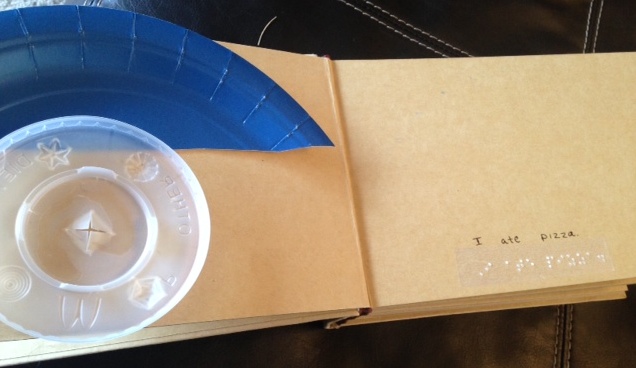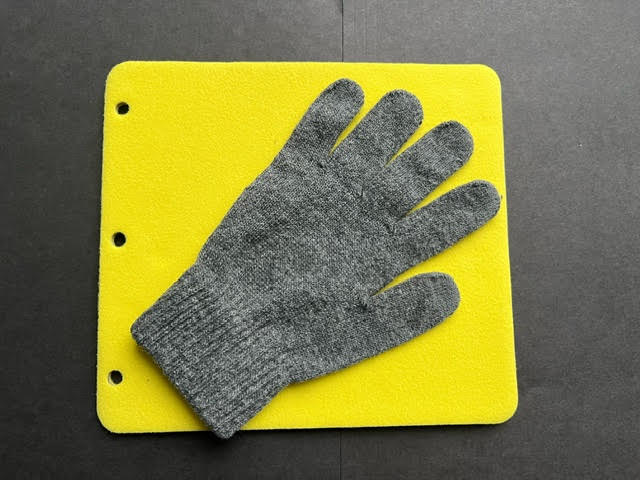By Sandra Lewis, Associate Professor and Coordinator, Program in Visual Impairment, College of Education, Florida State University, and Joan Tolla, Orientation and Mobility Specialist, Tift and Irwin County Schools, Georgia.
Reprinted from Teaching Exceptional Children, vol. 35, No. 3, pp. 22-28, Jan/Feb 2003, with permission from the Council for Exceptional Children.
Editor’s notes: The boxes referenced in the text are located at the conclusion of the article. Some graphic elements of the original article were not reproduced.
What do very young children learn about reading? According to many studies on developmental learning (see Box 1, “What Does the Literature Say?”), young children develop an appreciation that “reading” activities in which they engage are related to the words they speak and hear, and are further connected to the written symbols of our language. They observe others reading and writing within functional contexts and meaningful activities. Further, they develop important basic concepts about reading materials (see Box 2, “Book Concepts”).
But what about children whose vision is limited, or children who are blind? How do they participate in early reading activities? This article explores ways that educators, parents, and caregivers can ensure that all young children have a chance to learn to read.
Literacy Needs of Children With Visual Impairments
Obtaining access to the written symbols of language and observing adults and peers modeling reading and writing are not easily achieved for children with significant visual impairments. Visual impairment can directly interfere with the observation of symbols and events that are key to the development of early literacy skills. Many educators and researchers have discussed ways to purposefully introduce these young children to braille and print and to inform them of reading and writing activities of others (Harley et al., 1997; Swenson, 1999; Wormsley, 1997).
An even more significant issue related to emergent literacy for young children with visual impairments is the development of meaningful concepts through essential life experiences (Finello, Hanson, & Kekelis, 1992). Because children with visual impairments are restricted in their frequent, spontaneous, incidental access to the things and events in their world, their information about these items is limited, inconsistent, or fragmented (Ferrell, 1997).
In addition, a key learning characteristic of children with visual impairments is learning from part to whole. Because their perception is limited to what can be felt by the hand or seen within a limited visual field, children with visual impairments often have difficulty understanding the “gestalt” of an experience (Ferrell, 2000). A sighted child can frequently observe from a distance all of the objects that are stored in the desk drawer, are pulled out of the cabinet to wash the car, or are associated with a bath; but the child with visual impairment may not have had the same experiences or understanding. As a result, many children with visual impairments do not bring to the emergent literacy process the same kind and quality of information that young children with good vision do. Children with visual impairments may not understand what others read to them and what they are expected to read themselves (Koenig & Farrenkopf, 1997).
Illustrations in Books for Young Readers
Children with typical vision have an added advantage in the process of learning to read over young children who are blind or who have significant visual impairment. Sighted children can learn about things even if they have had no direct contact with them—animals, events, people, and objects—except through the illustrations in their books. The thousands of books published for emergent readers almost always include illustrations or pictures. These illustrations not only introduce children to information with which they may be unfamiliar, but these pictures facilitate understanding of the text. “Illustrations play a major role in enriching the story line, adding humor and intrigue, giving instant clues to what the story is about and enabling the reader to reconstruct the story line (often without reference to the text)” (Lamb, 1995, p. 7).
Illustrations also provide the bridge between listening and early reading behaviors (see Box 3, “Early Reading Behaviors”). Children only gradually become aware of the text. At first, they use the illustrations as prompts to recall the meaning and words of the story.
Tactile Illustrations
For young children who are blind or who have severe visual impairments, the visual aspects of books written for emergent readers present a significant problem. The obvious solution to this accessibility issue is the use of raised line drawings in conjunction with braille text. Interpretation of raised line drawings, however, is a far more difficult task than is recognition and identification of pictures. Raised line drawings attempt to present the 3-dimensional world in two dimensions. Although we can visually see the relationship, a circle is really very unlike the way a ball feels; the outline of a birthday cake bears no resemblance to its tactile reality. Similarly, the outline of the “Cat in the Hat” holding a fish cannot be easily related to the outline of the Cat sitting in a chair. The details and constancy that make even abstract illustrations so identifiable visually cannot be reproduced in a tactile form.
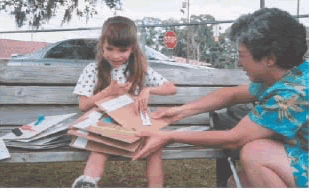
tactile experience book.
Another solution that frequently has been recommended is to create “story boxes” (Newbold, 2000), or “book bags” (Miller, 1985; Stratton & Wright, 1991; Wormsley, 1997). These items are similar in that objects related to either a published or unpublished story are used as illustrative props to bring meaning to the story. Miller, the mother of a child who is blind, first described her creative use of book bags, in which she stored objects mentioned in commercially published books. Miller and her children dramatized events in the stories they read using these objects. Others have recommended keeping the objects in a bag or a box, to stimulate recognition and discussion as they are handled and explored by the young child with visual impairment as the adult reads (Stratton & Wright, 1991; Wormsley, 1997).
Newbold’s (2000) story boxes were designed to address the problems young children with visual impairments often have in relating their experiences to the act of reading. She recommended that simple stories about a child’s experiences be written on note cards and included in a box with mementos from the event. The adult and child examine the objects together as the adult reads the story, which incorporates people and events that are familiar to the child.
Neither book bags nor story boxes address the need, for children who are blind, to be exposed to books on which the text and the objects or activities described by that text are presented on the same page. “Tactile experience books” can meet this need. In tactile experience books, artifacts from an event experienced by the child are actually incorporated onto the pages of a simple, sturdy book. Each page also includes braille and print text. Adults using these books with young children can encourage the association of words that are read with braille and the use of appropriate hand movements during story reading. Children can use these books independently; they can turn to a page, tactually explore the artifact attached to the page, and pretend to read the story aloud. Children with more experiences with these types of books can begin to recognize specific words based on their length, position in the text, or the letters with which they start or end.
Making Tactile Experience Books
Selecting topics for tactile experience books is as easy as examining the objects that are part of the environments in which students with visual impairments spend time. Events can be planned specifically to collect artifacts for a book, or artifacts can be collected as part of a naturally occurring event, such as a trip to a baseball game or an investigation of the school grounds. Ideally, the child participates in these collection activities, collecting and putting aside the objects to be used later in the book.
Regardless of the child’s involvement in his or her collection, artifacts must be items with which the child has come in contact tactually. Using car keys to represent going for a ride will not be appropriate unless the child has in some way used the keys, perhaps to unlock the car door. Using objects that the adult associates with an event, but which are unfamiliar to the child, is a common mistake of inexperienced bookmakers. In addition, artifacts used in the book must be real—not miniature representations of an object. Miniatures do not provide the same detail for the tactual learner that they provide to the visual learner. Thinking again of representing a ride in a car, a toy car would not be an appropriate artifact, unless perhaps, the child played with the toy car during the ride. In general, a toy car is very different from the car experience of a child who is blind or who has low vision. A better representative object might be a swatch of fabric from the child’s car seat or the seat belt buckle that the child has helped to fasten.
Preferred books are those that are easily handled by the child. Heavy cardboard should be used for the cover and pages, which should be securely fastened. We have found that metal rings are more durable than ribbon or string used to bind the pages. It is best for only one object (or category of object) to be placed on the page. Because an object that has been glued to the page creates a different experience than the same object held in the hand, we recommend that artifacts be affixed to the pages using loop fasteners (Velcro©) whenever possible, so that the child can experience them in three dimensions. Another way to assure that objects can be fully accessed by the child is to store them in Zip-lock bags that have been glued or stapled to the page. Large objects, which can add bulk to the book and make it unmanageable by small hands, can be attached by a string to a particular page and stored outside of the pages, to be pulled nearer by the child when that page is read.
Another method of incorporating a large object, such as the big bow from a birthday present, is to place the item on the cover. The child can use this artifact to identify the book and distinguish it from others in his or her collection. Covers don’t need to be fancy. Although it is visually meaningful to have a book about Jim’s trip on the city bus cut out in the shape of a bus, this shape doesn’t provide the same stimulus for the student with visual impairment. Keeping the transfer pass that the driver handed to the child as he or she boarded the bus and gluing it to the cover would be a more meaningful reminder of the trip.
Sighted children can easily identify the location of the text on the page, so its placement is not critical. The young reader who is blind is helped if the text can be found at a predictable location on the page. The braille text should be created on heavy braille paper in one continuous line. Words should not be cut apart and placed on the page as single units or phrases. The page of text should not be pasted to the page, since the adhesive can reduce the sharpness of the braille dots. We recommend stapling the text to the page, using Brailleables®, or gluing only the edges and corners of the page on which the text is brailled. Note: For many young children with visual impairments, the decision regarding use of braille or print for instruction has not been made. Therefore, it makes sense to include high-quality print versions of the text as well. The print can be created with a word processor on the page before the braille is affixed. Even for children who are blind, print included on the page will help parents, peers, and others share in reading the story.
Determination of whether the braille text should be created in alphabetic braille (where the braille matches the print exactly) or in Grade II braille (the format of braille used in commercially published materials, including schoolbooks) is based on many factors. The parents, early interventionist, and teacher of students with visual impairments, if one has been assigned, should make this decision jointly.
Books published for young children with vision feature text that is simple and often repetitive. This repetition helps the emerging reader to memorize the text, so that attention can be placed on correspondence between the text and spoken words. This same practice can be used in tactile experience books published for children with visual impairments. Though it is tempting to write long descriptive passages, young children benefit when there are few words on the page. They also benefit when phrases are repeated, such as “In my bathroom, there is a —-,” or “When we fixed the doorknob, we used—–.”
Mary’s Tactile Experience Book
Mary, who is totally deaf and blind, is in kindergarten in her local school district. A team of educators, including the second author, Joan, who is an orientation and mobility (O&M) specialist, provide support services to Mary. O&M specialists generally work on development of skills associated with travel, including use of the cane, body image, spatial concepts, sensory perception, and environmental-recognition skills. Joan decided that an “experience book” would be an ideal vehicle for reinforcing concepts of travel with Mary and approached the speech-language pathologist serving this student about working together on the project.
The two adults met with Mary and her interpreter in the school’s courtyard garden and explored the area, which included flowers, trees, a gazebo, and even rabbits. Since Mary was unfamiliar with any garden, questions such as “What do you think might be in a garden?” were not helpful. Therefore, the adults asked Mary to move around the garden and look for items to the left or right, on the ground, or up high. As they explored, they discovered various natural items that were appropriate for an experience book; Mary picked these up and placed them in a large bag.
Joan then prepared the simple lines of the story in braille and print. During their next meeting, Mary assisted Joan in the assembly of the book. The process went slowly as Mary explored each garden item, used sign language to identify it, and helped position it on the page. Mary affixed the items with tape; later, Joan prepared more permanent mountings. Joan arranged short braille sentences at the bottom of each page. The last page was left for Mary and Joan to work on together (see Box 4, “My Garden Walk” by Mary). Mary not only chose the words for this page, but also assisted in writing the sentences on the braillewriter.
At first, the book was kept in a resource room and left on a bookshelf so that Mary could easily retrieve it independently. Mary loved her book and read and explored the pages often, fingering the artifacts. Later, the general education classroom teacher asked to keep the book in her classroom, so that Mary could read it during the class’s independent reading time. Not surprisingly, the other kindergarten students also found the tactile experience book to be interesting; and they enjoyed sharing reading time with Mary and her book. The classroom teacher soon requested more books. Peers and adults have been encouraged to read the books aloud only when Mary is moving one hand across the braille while her interpreter signs the words into her other hand.
Other Tactile Experience Books
Peers have also been involved in the tactile experience books enjoyed by other students on Joan’s caseload. One of the favorites is a book titled, “Things for My Hair” (see Box 5). This book consists of 10 pages with large items attached with Velcro for easy removal and replacement and small items placed in Zip-lock bags. Even though the young students with visual impairments did not participate in making this book, they have enjoyed putting bobby pins, bows, clips, and scrunchies in their own hair, as well as into the hair of their peers and teachers.
Another creative teacher, Alysa Crooke of Pensacola, Florida, also used a hair theme to describe a field trip taken by one of her students to a local beauty parlor (see Box 6, “Chloe’s Makeover”). The following are two other books we have seen:
- My Bathroom—Repeated at the bottom of each page of this book is the text, “In my bathroom there is….” The artifacts included were soap, toothbrush, dental floss, trial size toothpaste, Q-tips, comb, ponytail holder, and a small piece of washcloth.
- Things in Mommy’s Purse—This book was stored in a large straw purse. It consisted of 7 pages, and all items were removable for easy exploration and manipulation. Objects included compact case, comb, small spiral notepad, credit card, pen, lipstick, and Velcro-closed wallet in which coins and a dollar bill had been placed. The text on each page read, “I looked in Mommy’s purse and found….”
Benefits
Tactile experience books offer a host of benefits to students with visual impairments. Because they describe personal experiences, children request that they be read, memorize their content with ease, and are eager to pretend to read them aloud to listening adults. Early book skills are mastered, grapheme-phoneme connections are initiated, and the pleasure of reading with adults and peers is reinforced.
Tactile experience books also can be used to present children with visual impairments opportunities to practice other important skills, including those in the motor domain. One 2-year-old who is totally blind learned the difficult skill of opening a paper bag and placing an item in it on a windy day. Almost all of the young students with whom we have used tactile experience books have learned how to open and close Zip-lock bags, skills to which they previously had not been introduced. For many others, further fine motor practice has been provided in removing items from strong Velcro, from fastening barrettes in the hair of their friends, and from turning open the cap on a tube of toothpaste. Although seemingly very rudimentary, these are exactly the kinds of skills that adults assume young children with visual impairments are learning, and are surprised that they do not have when they enter school.
Similarly, tactile experience books can be used to reinforce spatial, temporal, and number concepts. They can facilitate meaningful expansion of language, social skills, and tactual perception.
As we described the creation and use of tactile experience books to parents of children with significant visual impairments, we found that many parents are surprised to think that their children might be unfamiliar with common items found in their home, how these items are used, and how they compare with one another. We have used these discussions as opportunities to help parents better understand the impact of visual impairment on development and learning, and consequently, to appreciate the critical importance of actively involving children in the simple events that occur around them.
Cautions
Although tactile experience books seem simple to make, their creation requires both time and careful planning, especially if the child is involved in the collection of the artifacts and the making of the book. Breaking the task into several components is recommended to maintain the interest of the young child.
The parents and general education teachers who have worked with us have not been enthusiastic about including artifacts that can cause a mess, such as shampoo, toothpaste, or lipstick. Although we tend to favor these kinds of artifacts because students with visual impairments have such few opportunities to experience them in other contexts, we recognize the potential problem. In the purse story described previously, it was decided to substitute clear lip-gloss for the lipstick after a teacher complained of the messy students. Putting only small portions of liquid in containers is one solution to the problem, so that any spill that is created is small enough to easily clean (by the student, we would hope).
Finally, the objects included in books for very young readers must not present a choking hazard should they be put in the child’s mouth. For infants and very young children, adult supervision when independently reading some tactile experience books may be necessary.
Final Thoughts
Tactile experience books can support the emergent literacy development of young children with visual impairments in a variety of ways. When tactile experience books are made available to early readers, these students practice
- Turning pages.
- Orienting books.
- Exploring objects.
- Using the hand movements associated with braille.
- Experiencing independent pleasure reading.
At the same time, these children have the opportunity to see the connection between words that describe the activities in which they engage and the stories that they read—a key prerequisite for reading. They also gain experiences with writing and the symbols of the written language that they will be using in school.
We have also seen how tactile experience books support the social inclusion of preschool children with visual impairments in their general education classrooms. Children with visual impairments have meaningful stories from which to choose during reading time, and can share these stories with others, both as a competent “reader” and as a listener.
Lamb (1995) observed that students with visual impairment do not experience the same immersion in literature that children with vision do. Swenson (1999) agreed, noting that “because of the scarcity of braille materials, children who are blind or have very low vision…do not automatically participate in…[early] literacy learning. Instead, their `braille immersion’ must be deliberately orchestrated by teachers and parents” (p. 11). The addition of tactile experience books to the bookshelves of young children with visual impairments is an important “instrument” of that orchestration.
Box 1
What Does the Literature Say About Learning to Read?
Developmental Reading Process. Learning to read is a developmental process that begins at birth (Lamb, 1995; Rex, Koenig, Wormsley, & Baker, 1994; Snow, Burns, & Griffin, 1998), one that can be positively influenced by the involvement of parents and other caretakers.
Recommendations for facilitating the early literacy experiences of young children include the following:
- Providing a print-rich environment (Clay, 1991; Handel, 1999; Purcell-Gates, 2000; Sawyer & Comer, 1996).
- Modeling reading behavior (Handel, 1999; Purcell-Gates, 2000; Sawyer & Comer, 1996).
- Reading aloud to even the youngest infants and toddlers (Anderson, Hiebert, Scott, & Wilkinson, 1985; Purcell-Gates, 2000; Sawyer & Comer, 1996).
In fact, being read to may be the most important factor in preparing a child to become a good reader (Anderson et al., 1985).
Emergent Literacy. The phase of reading development during which infants and toddlers begin to become familiar with written language and the process of learning to read and write is known as emergent literacy (Harley, Truan, & Sanford, 1997; Wormsley, 1997).
Box 2
Book Concepts
- Books are generally made of paper, but may also be made of other materials such as cloth or plastic.
- Books contain pages to be turned one at a time; pages are numbered.
- Books may have pictures and words written on the pages.
- Pictures resemble familiar objects.
- Pictures and books have a top and bottom, front and back.
- Books give information and pleasure.
- Language is constant on each page.
- Language can be remembered and related to specific pages or pictures.
- Information presented in books stimulates the child’s own related ideas.
- Printed symbols tell the reader what to say.
- Printed symbols are read from left to right and from top to bottom.
Source: Adapted from Communication skills for visually impaired learners (2nd ed.), by R. K. Harley, M. B. Truan, & L. D. Sanford, Springfield, IL: Charles C Thomas, 1997.
Box 3
Early Reading Behaviors
- Child pretends to “read” storybooks; may run finger along printed text.
- Child associates some letters with their representative sounds.
- Child recognizes key words in familiar stories
- Child enjoys listening to story.
- Child talks about the pictures.
- Child completes familiar lines in story based on memory.
- Child uses physical and visual cues surrounding print to make up story.
Box 4
“My Garden Walk” by Mary
Title cover: “My Garden Walk” by Mary: Glued to the center of the cover page were several pebbles from the path on which Mary had walked.
Page 1: Brailled sentence at the bottom of the page read. “I went for a walk in the school garden. I found 1 piece of tree bark.” Glued to the center of the page was a large piece of tree bark.
Page 2: Brailled sentence “On the ground were 3 stones. Count them with me.” 3 stones, one small, medium, and large, were glued onto this page.
Page 3: Braille sentence, “I have 4 limbs from a tree.” Arranged in increasing size were 4 limbs from various trees.
Page 4: Brailled sentence, “I picked 3 leaves, one large, one medium, and one small.” In descending size, three different leaves were glued onto the center of the page.
Page 5: Brailled sentence, “I petted one bunny rabbit.” In a plastic Zip-lock bag glued to the center of the page was bunny fur found on the ground near the bunny’s cage.
Page 6: Brailled sentence, “I picked a flower.” One flower from a bush was attached to the center of the page.
Page 7: Brailled sentence, “I had fun walking with Ms. Joan.” Stapled to this page was the elastic from the handle of a discarded cane like the one used by Mary.
Box 5
Things for My Hair
Title Cover: “Things for My Hair” A hairbrush was attached to cover with Velcro.
Page 1: “Shampoo to clean my hair. Conditioner to make it soft.” Small travel-size containers filled with a little shampoo/conditioner attached at the center of the page with Velcro.
Page 2: “A brush and combs for my hair.” Two combs and one small brush were attached to the page with Velcro. A large brush was attached to a string and hung outside of the book.
Page 3: “Hair rollers to help curl my hair.” Various sizes and makes of rollers were placed into a small plastic bag. The bag was fastened at the top of the page with Velcro.
Page 4: “Large and small barrettes hold my hair in place.” Various sizes and types of barrettes were placed in a bag, and the bag was fastened at the top of the page with Velcro.
Page 5: “Bobby pins hold my hair in place.” Large, small, and medium-size bobby pins were placed in a bag that was attached to the page.
Page 6: “Ponytail holders keep my hair in a ponytail.” Same as pages 4 and 5.
Page 7: “Clincher combs keep my hair back.” Same as pages 4 and 5.
Page 8: “Headbands keep my hair out of my face.” Same as pages 4 and 5.
Box 6
Chloe’s Makeover
Ms. Margaret called Chloe and said, “Please come over, I have time today to give you a makeover.”
Chloe was excited. She started to squirm. She had to wait on a lady getting a perm.
“Let’s use a comb to comb your hair nice. Let’s use a pick. We’ll comb your hair twice.”
Ms. Margaret said, “I know. Let’s give your hair curls. This hairstyle looks wonderful on little girls.”
“Which barrettes would you like to wear? You have good taste. They look great in your hair.”
Next, Chloe got her nails painted and filed. Ms. Margaret said, “Beautiful.” Chloe just smiled.
Chloe was good, so she got a treat …A butter rum sucker, she was happy to eat.
Ms. Margaret said, “You’re done. It’s time to pay.”
“Thank you, Ms. Margaret. I had such fun today.”
References
Anderson, R. D, Hiebert, E. H., Scott, J. A., & Wilkinson, I. A. (1985). Becoming a nation of readers: The report of the Commission on Reading. Washington, DC: National Academy of Education, National Institute of Education.
Clay, M. M. (1991). Becoming literate: The construction of inner control. Birkenhead, Auckland, New Zealand: Heinemann Education.
Ferrell, K. A. (1997). Preface. What is it that is different about a child with blindness or visual impairment? In P. Crane, D. Cuthbertson, K. A. Kerrell, & H. Scherb (Eds.), Equals in partnership. Basic rights for families of children with blindness or visual impairment (pp. v-vii). Watertown, MA: Perkins School for the Blind and the National Association for Parents of the Visually Impaired.
Ferrell, K. A. (2000). Growth and development of young children. In M. C. Holbrook & A. J. Koenig (Eds.), Foundations of education (2nd ed.). Volume 1: History and theory of teaching children and youths with visual impairments (pp. 111-134). New York: AFB Press.
Finello, K. M., Hanson, N. H., & Kekelis, L. S. (1992). Cognitive focus: Developing cognition, concepts, and language in young blind and visually impaired children. In R. L. Pogrund, D. L. Fazzi, & J. S. Lampert (Eds.), Early focus: Working with young blind and visually impaired children and their families (pp. 34-49). New York: American Foundation for the Blind.
Handel, R. D. (1999). Building family literacy in an urban community. New York: New York Teachers College Press.
Harley, R. K., Truan, M. B., & Sanford, L. D. (1997). Communication skills for visually impaired learners: Braille, print, and listening skills for students who are visually impaired (2nd ed.). Springfield, IL: Charles C Thomas.
Koenig, A. J., & Farrenkopf, C. (1997). Essential experience to undergird the early development of literacy. Journal of Visual Impairment and Blindness, 91(1), 14-24.
Lamb, G. (1995). Fingerprints: A whole language approach to Braille literacy. Manurewa, Auckland, NZ: Homal Vision Education Centre.
Miller, D. D. (1985). Reading comes naturally: A mother and her blind child’s experiences. Journal of Visual Impairment and Blindness, 79(1), 1-4.
Newbold, S. (2000). Emergent literacy for young blind children. Phoenix, AZ: FBC Publications.
Purcell-Gates, V. (2000). Family literacy. In M. L. Kamil, P. B. Mosenthal, P. D. Pearson, & R. Barr (Eds.), Handbook of reading research, Volume III (pp. 853-870). Mahwah, NJ: Lawrence Erlbaum.
Rex, E. J., Koenig, A. J., Wormsley, D. P., & Baker, R. L. (1994). Foundations of Braille literacy. New York: AFB Press.
Sawyer, W. E., & Comer, D. E. (1996). Growing up with literature. Albany, NY: Delmar.
Snow, C. F., Burns, M. S., & Griffin, P. (Eds.). (1998). Preventing reading difficulties in young children. Washington, DC: National Academy Press.
Stratton, J. M., & Wright, S. (1991). On the way to literacy: Early experiences for visually impaired children. Louisville, KY: American Printing House for the Blind.
Swenson, A. M. (1999). Beginning with Braille: Firsthand experiences with a balanced approach to literacy. New York: AFB Press.
Wormsley, D. P. (1997). Fostering emergent literacy. In D. P. Wormsley & F. M. D’Andrea (Eds.), Instructional strategies for Braille literacy (pp.17-55). New York: AFB Press. 27.
